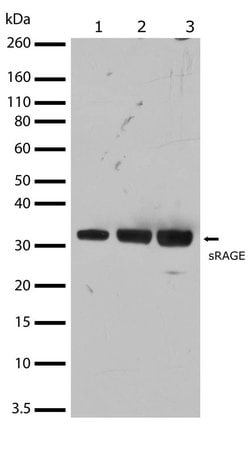Learn More
Invitrogen™ RAGE Recombinant Superclonal™ Antibody (17HCLC)
Rabbit Recombinant Superclonal Antibody
Supplier: Invitrogen™ 710339
Description
This antibody is predicted to react with mouse, rat, non-human primate and rabbit based on sequence homology. Recombinant rabbit Superclonal™ antibodies are unique offerings from Thermo Fisher Scientific. They are comprised of a selection of multiple different recombinant monoclonal antibodies, providing the best of both worlds - the sensitivity of polyclonal antibodies with the specificity of monoclonal antibodies - all delivered with the consistency only found in a recombinant antibody. While functionally the same as a polyclonal antibody - recognizing multiple epitope sites on the target and producing higher detection sensitivity for low abundance targets - a recombinant rabbit Superclonal™ antibody has a known mixture of light and heavy chains. The exact population can be produced in every lot, circumventing the biological variability typically associated with polyclonal antibody production. Note: Formerly called Recombinant polyclonal antibody, this product is now rebranded as Recombinant Superclonal™ antibody. The physical product and the performance remain unchanged.
The Receptor for Advanced Glycation End-products (RAGE) is a gene located on human chromosome 6p21.3, encoding a transmembrane receptor belonging to the immunoglobulin superfamily. RAGE is expressed in various tissues, with significant levels in the lungs, and plays a crucial role in cellular signaling and inflammation. As a receptor, RAGE binds multiple ligands, including advanced glycation end-products (AGEs), amyloid-β peptide, high mobility group box 1 (HMGB1), and S100/calgranulin proteins, facilitating diverse pathological processes like inflammation, cancer progression, and neurodegeneration. The interaction between RAGE and its ligands triggers intracellular signaling pathways such as NF-?B activation, leading to inflammatory responses and oxidative stress. In the context of chronic diseases like diabetes, Alzheimer's, and cardiovascular diseases, RAGE is a critical mediator, linking metabolic disturbance to cellular dysfunction. Therapeutic targeting of RAGE signaling is under investigation, aiming to mitigate its contribution to inflammatory and degenerative diseases.
Specifications
| RAGE | |
| Recombinant Superclonal | |
| 0.5 mg/mL | |
| PBS with 0.09% sodium azide | |
| Q15109 | |
| AGER | |
| Recombinant protein corresponding to amino acids 23-342 of human sRAGE. | |
| 100 μg | |
| Primary | |
| Human | |
| Antibody | |
| IgG |
| Western Blot | |
| 17HCLC | |
| Unconjugated | |
| AGER | |
| advanced glycation end product receptor; advanced glycation end-product receptor; advanced glycation end-products receptor; advanced glycosylation end product-specific receptor; advanced glycosylation end product-specific receptor variant 2; advanced glycosylation end product-specific receptor variant 3; advanced glycosylation end product-specific receptor variant 4; advanced glycosylation end product-specific receptor variant 5; advanced glycosylation end-product specific receptor; Ager; MAPK/MAK/MRK overlapping kinase; MOK; MOK protein kinase; RAGE; RAGE isoform NtRAGE-delta; RAGE isoform sRAGE-delta; RAGE/AGER; RAGE1; RAGE-1; RAGE-4 ORF3; receptor for advanced glycation endproducts; receptor for advanced glycation end-products variant 20; receptor for advanced glycosylation end products; receptor of advanced glycosylation end products of proteins; immunoglobulin superfamily; MHC class II; MHC class III; renal cell carcinoma antigen; renal tumor antigen 1; SCARJ1; sRAGE; STK30 | |
| Rabbit | |
| Protein A | |
| RUO | |
| 177 | |
| Store at 4°C short term. For long term storage, store at -20°C, avoiding freeze/thaw cycles. | |
| Liquid |
Safety and Handling
Your input is important to us. Please complete this form to provide feedback related to the content on this product.
